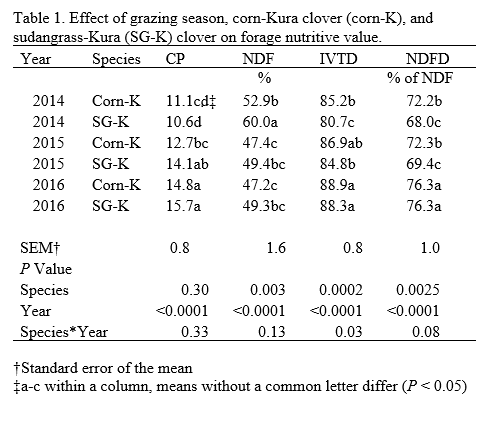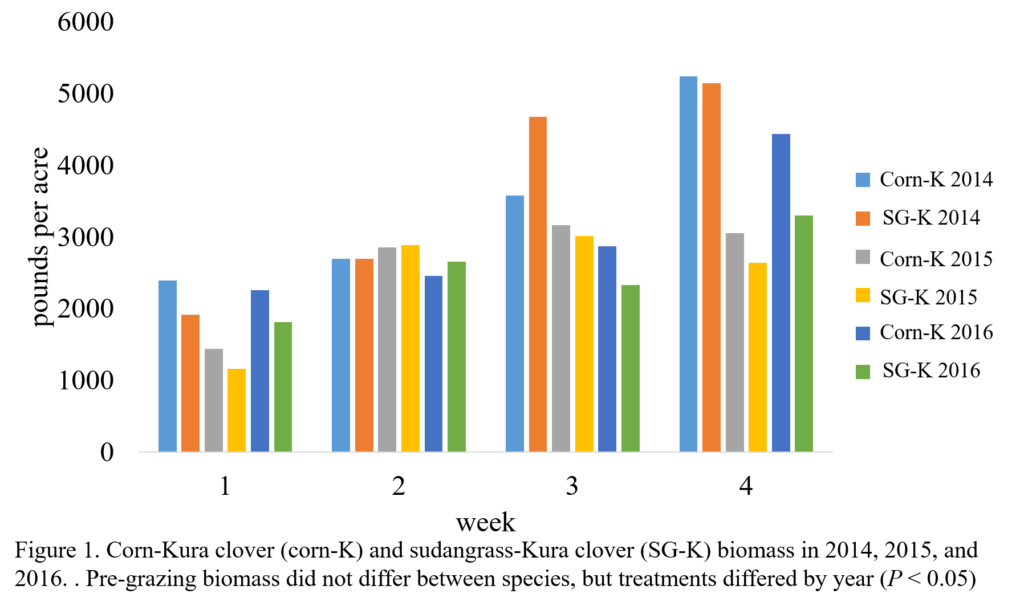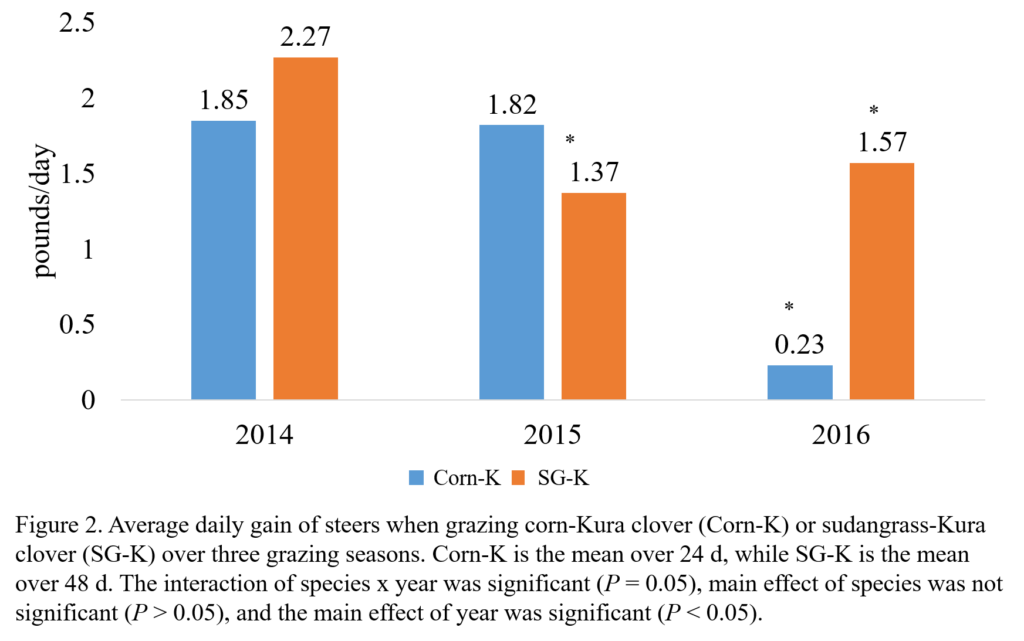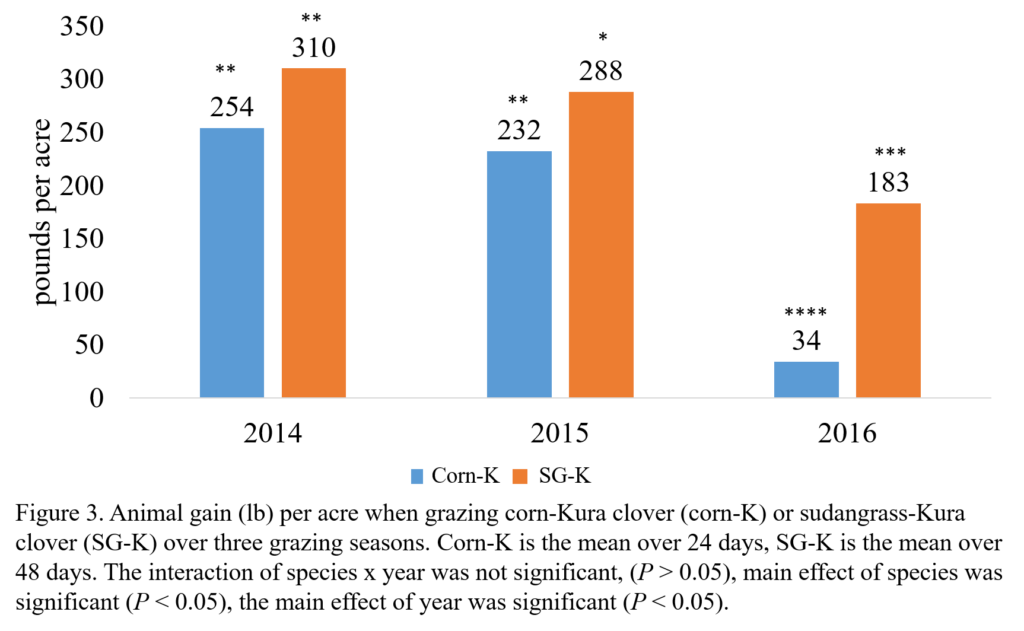Final report for GNC15-206
Project Information
Warm season annuals such as corn (Zea mays L.) and brown mid rib (BMR) sudangrass [Sorghum bicolor (L.) Moench.], can increase the carrying capacity of grazing farms by producing great amounts of forages during mid-summer, when cool season pasture growth rates decline. These warm season annuals can be interseeded into a perennial forage, such as Kura clover, to reduce soil erosion and provide forage of greater digestibility and protein to grazing cattle. In addition, cereal rye can be added to the system to provide weed control and additional grazing forage in early spring.
The study was conducted from 2014 to 2016 at the Arlington Agricultural Research Station in Arlington, WI. Pre-grazing biomass did not differ between species. Corn averaged 3033 ± 174 lb ac-1 (mean, SEM), while sudangrass averaged 2926 ± 143 lb ac-1, but treatments differed by year (P < 0.05). Harvested forage yield was greater (P< 0.05) in sudangrass-Kura clover, averaging 3071 ± 199 lb ac-1, while corn-Kura clover averaged 2164 ± 172 lb ac-1. Average daily gain was not different (P > 0.05) between corn-Kura clover (1.3 ± 0.24 lb d-1) and sudangrass-Kura clover (1.7 ± 0.12 lb d-1). Average daily gain was affected by year and year by species (P < 0.05). Corn-Kura clover had a lower (P = 0.05) gain per acre, 174 ± 41 lbs per acre, than sudangrass-Kura clover, 284 ± 41 lbs per acre, and there was also a year effect (P < 0.05) and a tendency for a year by species effect (P = .09). Though no differences in ADG were detected, greater gain per acre was achieved due to more grazing days for sudangrass-Kura clover. Economic comparison on a per acre basis was favorable for the sudangrass-Kura clover system, because of increased gain per acre compared to corn-Kura clover. However, when compared to adjacently grazed perennial cool season pastures (binary mixtures of alfalfa and grasses, gain per acre averaged 810 lbs per acre), costs were much greater for both annual systems without increased gain per acre. The input/output difference for the average cool season perennial system over the 4 years (establishment plus research years) was $2075 per acre, while sudangrass-Kura clover was $102 per acre and corn-Kura clover was $-477 per acre, concluding that cool season perennial systems are more profitable in this comparison. However, similar ADG between the cool season perennial system and the proposed warm season system is promising, but adjustments are necessary for the warm season system to increase gain per acre.
The objectives of this study were to quantify annual forage production, forage nutritive quality, and animal gain on sudangrass and corn interseeded into Kura clover. To compare the two systems forage production, forage nutritive quality, animal gain, and number of grazing days were measured. Additionally, an economic analysis will be completed to determine the costs of planting and maintaining both systems, plus a comparison to a typical cool season perennial system.
Cooperators
Research
The experimental designs consist of two treatments, corn with Kura clover, and BMR sudangrass with Kura clover, both preceded by winter rye with Kura clover. Kura clover was seeded in late summer 2013. Weed control in the warm-season component was accomplished by fall-seeding winter rye and early spring grazing of this mixture. Corn and BMR sudangrass was planted each year in early June, with grazing starting 4 to 6 weeks after planting. Each treatment had three replicates, resulting in a total of six 2.82 acre pastures. Each pasture was further divided into 8 paddocks, each of which was be grazed for 3 days. Corn-Kura clover was grazed once over 24 days, while sudangrass-Kura clover was grazed as many times as possible while maintaining a 24 day rotation.
Steers weighing 500 to 550 lbs were be purchased in early April. Grazing commenced as soon as there was enough pasture growth to maintain five “tester” steers per paddock for 3 days. Tester steers from the rye-Kura clover pastures were used as testers on the warm season pastures. Grazing commenced in the warm-season pastures when BMR sudangrass height was over 28 inches, to avoid prussic acid poisoning. Grazing was managed via a “put and take system”, meaning that when forage production exceeded the requirements of the tester steers additional non-tester steers were used to consume excess forage. Carrying capacity was calculated by multiplying the average tester weight by the average number of steers exposed, weighted by steer days, over the time period, and then divided by the total land area in the experimental unit. Steers were weighed every 24 days or before and after each full grazing rotation.
Pre-grazing forage samples were collected once per week for the entire grazing season in the paddock that was next in sequence for grazing, followed by a post-grazing biomass sampling. Sudangrass-Kura clover samples were hand clipped 2 in above ground level from three random areas in the paddock. Quadrats of 3.06 ft2 were used for sudangrass, to accommodate a row spacing of 7 in. Corn-Kura clover sampling involved hand-clipping stalks to 2 in above ground level from 10 ft of row from three random locations in the paddock. The same respective methods for each treatment were used for the post-grazing samples.
Forage samples were dried in a forced air oven at 55°C, weighed, and used as an estimate of forage mass. Post-grazing sample mass was subtracted from pre-grazing sample mass to estimate the amount of forage consumed and grazing efficiency. Dried samples were ground and composite samples were analyzed for neutral detergent fiber, in vitro true digestibility, and crude protein.
Data was analyzed by ANOVA as a completely randomized design using the MIXED procedure in SAS with pasture as the experimental unit. Repeated measures analysis was included for forage biomass and quality variables. Average daily gain was analyzed similarly as a completely randomized design with group of tester steers as the experimental unit.
Forage production:
Visual observations of corn and sudangrass in years 2015 and 2016 indicated nitrogen deficiency. Soil samples were not taken to confirm nitrogen deficiency. Most likely, any available N mineralized by natural death of Kura clover tissue was reutilized by new Kura clover growth. Producers may want to consider applying nitrogen to increase grass production.
Corn-Kura clover and sudangrass-Kura clover did not differ in their average pre-grazing biomass (Figure 1) over the 4 or 8 wk grazing sessions, though a year effect did exist.
Total forage harvested represents the sum of forage harvested over the grazing period, and was greater for sudangrass-Kura clover than corn-Kura clover. Total forage harvested for the treatments averaged 2364 ± 172 and 3072 ± 199 lb ac-1 for corn-Kura clover and sudangrass-Kura clover, respectively. Sudangrass-Kura clover, though stocking rates were lower, had a greater number of grazing days, 48 vs 24, resulting in greater total forage harvested per acre.
Nutritive Value
Several differences for nutritive value were detected between the two treatments and a year effect (P < 0.0001) was detected for all variables (Table 1). Regression analysis revealed an increase in the proportion of Kura clover biomass (y) in the corn-Kura clover treatment over the three years (x) (y = 0.26 + 0.14 (± 0.03) x, P<0.0001, R-squared = 0.35) from approximately 40% to 65%. Therefore, crude protein (CP) increased for 2014, 2015 and 2016, respectively, consistent with decreases in neutral detergent fiber (NDF) and increases in invitro true digestibility (IVTD) and neutral detergent fiber digestibility (NDFD). Crude protein was the only nutritive variable that did not differ (P = 0.30) between treatments (13.5 ± 0.36 and 12.9 ± 0.43% for sudangrass-Kura clover and corn-Kura clover, respectively).
Neutral detergent fiber concentration was higher in the sudangrass-Kura clover treatment (49.1 ± 9.4 and 529 ± 0.7% for corn-Kura clover and sudangrass-Kura clover, respectively), but IVTD and NDFD were more desirable for sudangrass-Kura clover (IVTD 87.0 ± 0.47 and 84.6 ± 0.39, NDFD 73.6 ± 0.59 and 71.2 ± 0.48%, for corn-Kura clover and sudangrass-Kura clover, respectively). The species by year interaction for IVTD (P = 0.03) supports the interpretation that Kura clover was making a greater contribution to quadrat samples, thereby diminishing the IVTD difference in 2016 that existed between treatments in 2014. Although there is no separate measure to show increases in Kura clover in the sudangrass-Kura clover treatment, it was observed that the proportion of Kura clover increased over the three years.
Animal Performance
Average daily gain did not differ between the two treatments (Figure 2), though there were species x year and year effects (P < 0.05). Differences between treatments may have been difficult to detect because of the short interval (24 d) between body weight determinations, during which gut fill may have had an influence. During the first 24 d on the sudangrass-Kura clover treatment, gains (0.46 lb d-1) were similar to the corn-Kura clover treatment. The sudangrass-Kura clover mean in Figure 3 represents the average of 48 d. Steers on the sudangrass-Kura clover treatment recovered from the first 24 d and performed well in the second 24 days (ADG = 1.92 lb d-1).
Values for gain per acre were greater in the sudangrass-Kura clover treatment (Figure 3) due to the grazing of sudangrass-Kura clover regrowth. A year effect was present (P < 0.05) because of low ADG values resulting in low gain per acre in 2016. Weather conditions are believed to be the cause of low ADG and gain per hectare in 2016. Heat stress often reduces dry matter intake, subsequently reducing animal gain.
Economic analysis
The average input and output on a per acre basis was calculated for 5 systems, alfalfa-tall fescue, alfalfa-meadow fescue, alfalfa-orchardgrass, sudangrass-Kura clover-rye, and corn-Kura clover-rye. For the alfalfa-grass system, inputs were pasture establishment- tillage, planting, seed costs, and pasture rent. Establishment costs were all in year 1, pasture rent costs were added each year. For the annual warm season-Kura clover-rye systems, inputs were Kura establishment-tillage, planting, seed costs, and pasture rent for year 1. Years 2-4 included costs for clipping and herbicide (prior to warm season planting), seed costs for the warm season annual and cereal rye, and pasture rent. Outputs were calculated based on beef gain per acre for each system, multiplied by the value per lb of gain determined by purchase and sale price for 2013 ($1.20/lb of gain).
The perennial system was greatly superior to the annual system due to the one time establishment costs of a perennial system and higher gain per acre. Beyond year 1, only pasture rent was charged for the perennial system, while the annual system needed to be clipped, sprayed, and replanted each year. The input/output difference for the average cool season perennial system over the 4 years (establishment plus research years) was $2075/acre, while sudangrass-Kura clover was $103/acre and corn-Kura clover was $-475/acre. Seed corn was twice as expensive as sudangrass grass seed for the input costs ($105 vs $52), but the lower outputs (beef produced per acre) in corn created the deficit in revenue for the corn-Kura clover system allowed for a better overall system. Gain per acre in the perennial system averaged 810 lbs per acre. Considering the low input costs and high beef production per acre, the perennial system far out preformed the annual system. There are limited options for decreasing the input costs of the annual system as proposed, buying less expensive sudangrass and non-GMO corn, but there is greater potential to improve output of the annual system.
Several management changes could be made to the annual system to make it generate more beef per acre. Applying nitrogen, although this would increase input, could greatly increase early forage production, particularly in sudangrass, potentially resulting in 3 to 4 grazings a summer, rather than two. Corn grazing could be made to last longer throughout the summer season, rather than just 4 weeks, by “stockpiling” and grazing for several more weeks. There were not great changes in corn-Kura clover nutritive quality throughout the season, and even though corn plants may mature through stockpiling, the Kura clover component should more than make up for any decreased digestibility.
The annual system proposed in this research was able to maintain cattle growth rates similar to those on perennial cool season forages in mid-summer, but improvements need to be made to the system to either reduce input costs or increase cattle gain per acre.




Educational & Outreach Activities
Participation Summary:
Project Outcomes
Impacts
Summer of 2016 was the final field season for this project. Information generated from this project has already been disseminated through a field day at the Arlington Agricultural Research Station in August 2016. There were approximately 20 people in attendance to join the discussion about managing the summer slump. This information was also disseminated at the annual Grassworks Conference. The presentation included all three years of data. This work was described in greater detail in a dissertation and is being prepared for publication.
Accomplishments
The objectives have met for this project and a thorough investigation has been completed. Both the sudangrass-Kura clover and corn-Kura clover treatments supply high quality forage in mid-summer. Under the experimental conditions in this study, few differences occurred between treatments. However, due to the extra 24 days of grazing, the sudangrass treatment did outperform the corn treatment in total forage harvested, producing 30% more forage harvested. The two forage treatments allow for different strategies for management and can easily be adapted to fit the needs and goals of the producer.
However, when we look at the systems in comparison to a cool season perennial pasture, our proposed warm season system needs considerable adaptation to be economically sustainable for beef producers in Wisconsin.
Over the course of this project my advisor and I became more aware of sustainable practices that farmers were already using. The beef producers that we worked with were very interested in our project, and we were surprised to see how many producers were already undertaking sustainable practices. We were able to emphasize the importance of forage nutritive quality and its impacts on steer gains, while also, beef producers were able to give us very valuable and practical input on how to improve the systems used in our research. Through these interactions, we became more aware of both, sustainable practices that were already in use, and beef producers interest in learning more and continuing their sustainable practices.